Unlike previous improvements in mechanical systems that have led to innovation in the automotive industry, 90% of the innovation in next-generation vehicles comes from more complex integrated circuits. Semiconductor devices play a very important role in meeting customers' needs for automotive functions.
This article refers to the address: http://
According to Frost & Sullivan, the automotive semiconductor market in Western Europe will nearly double in the next few years. The shift from electronics used in high-end cars to low-end cars is one of the reasons for this rapid growth.
The modern high-end electronic system is a highly decentralized real-time system that is connected to up to five bus systems by a control unit consisting of more than 300 motors or solenoid valves with 100MB of embedded code to provide the power system , safety, comfort, information and communication functions.
Power transmission regulates fuel consumption and emissions. Automakers claim that one of their goals is to produce three-liter cars and meet the Euro 3 standard and the Kyoto agreement. Without the support of electronics and software, it is impossible to achieve strict control regulations.
Therefore, these technical means are gradually being applied to hybrid generators or vehicles using fuel cells. Another trend is that diesel-powered cars are gradually replacing gasoline-powered cars.
The safety and comfort of cars has become increasingly important. The market is increasingly demanding the safety of riding a car. Car manufacturers have taken steps to this. At the same time, various technologies, such as anti-lock brake systems or airbags, have become standard equipment for many small and medium-sized cars.
Various technologies such as electronic stability programs or traction control systems have entered the high-end automotive market, and its entry into low-end cars is only a matter of time.
By implementing a variety of new applications to enhance the comfort of the car, such as keyless entry, seat control, interior environmental control or navigation control, car manufacturers strive to provide products that are different from their competitors in order to gain a competitive advantage.
It is foreseeable that further demand from the market comes from communication and information networks in automobiles. People expect their cars to receive broadcast, video, mobile communications, navigation systems and digital audio/video broadcasts.
Remote traffic control and services are also available in the near future.
The 42V grid has become the focus of discussion in recent years. Although each automotive semiconductor supplier is already available with 42V compatible products, there is still controversy about the time of product introduction and mass production. It is clearly foreseen that the 42V power network will come. According to data provided by Frost & Sullivan, half of the new cars in 2015 will use 42 V power network technology.
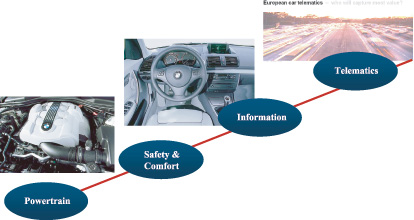
Figure 1. In the future, more than 90% of automotive innovations are driven primarily by electronics and software.
Test challenge
The main consideration for ATE manufacturers is that the maximum voltage on VBAT must remain below a certain limit (typically 68 V). Within this voltage limit, the car does not require further protection against large voltages posing a hazard to humans. The car is "low voltage", the same applies to the 42V power network, the voltage must not exceed 68 V.
The other case is "negative battery." This situation is difficult to handle for a 42V car because the voltage is tripled and the voltage cannot fall below -2V, so even a car with a 42V power network is still in low voltage modulation. It is clear that the 42 V power network cannot drive large negative voltages, but adds the need for VI channels that can provide 42 V/80 V.
In addition, automotive bus systems require high-voltage digital pins for functional testing, with voltage requirements up to 20 V. Test equipment manufacturers have to take this into account.
The automotive market is increasingly competitive in terms of price and quality. This means that semiconductor manufacturers have to find high-performance, cost-effective and low-cost test solutions to reduce production costs and ensure that profit margins are maintained at a certain level.
The trend in automotive devices is to integrate various technologies in a single chip, package or module, the so-called "system on a chip." Sensors are becoming more and more important. They are used in safety systems such as airbags, driving controls or automotive power systems.
The rapid growth of the market over the past 10 years has set a serious challenge for achieving quality, time to market and cost targets. Therefore, the design process of automotive electronics is a key factor in the success of future automotive projects. The life cycle of automotive electronics is very important to semiconductor manufacturers. The development process (including the usual redesign) takes 12-36 months. The car model changes every 6 to 8 years, but the electronic device replacement cycle is only 2 to 4 years. The product usage time is at least 10 years. As a result of the adoption of new technologies, electronic devices may change faster and at the same time create a competitive advantage for automakers.
The serious challenges in the design and testing of automotive devices are the requirements for yield and failure rate. The failure rate of a mobile phone is allowed to be 0.5%, and the failure rate of an automotive device must be less than 0.005%. The test requirements of the new device even exceed the following requirements: the ASIC failure rate is less than 0.0003%, the standard device failure rate must be less than 0.0001%, and the discrete device failure rate cannot exceed 0.00005%.
To manage the ever-increasing design complexity and maintain the economics of design work, complex design and test tools must support parallel and distributed specification, design, implementation, integration, and test work and test solutions.
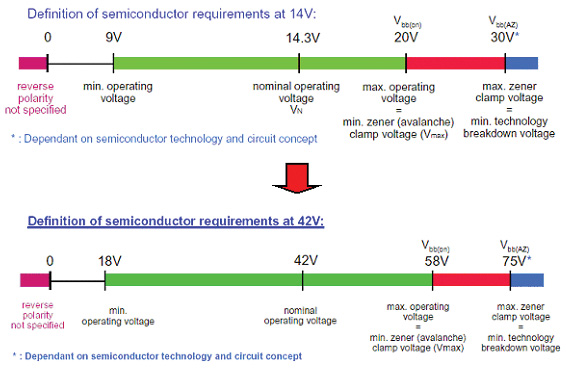
In Figure 2, the semiconductor devices operate at 14 V and 42 V, respectively.
Test solution
The complexity of the device requires a high-performance, highly flexible ATE system, but at the same time it must increase productivity to maintain profit margins and profit. To achieve this goal, chip parallel testing must be used to increase productivity and reduce testing costs. The time to create a new application must be as short as possible to match the generation and maintenance of the new test program.
For automotive hybrid signal test systems, the biggest challenge is to provide digital, analog, DSP, and power testing capabilities in a comprehensive, cost-effective solution. The system architecture must be scalable to cover the extensive testing needs of automotive electronics. Flexibility and speed can be achieved with the true structure of each pin tester. High-speed system buses must provide maximum capacity and lowest test costs. High performance instruments must be fully synchronized with the digital graphics. The mixed-signal pin electronics must be capable of supporting high data rates up to 50 MHz, providing a voltage swing of -2 V to +28 V.
Collidon's complex power mixed-signal test systems Falcon and Piranha are able to meet these challenges.
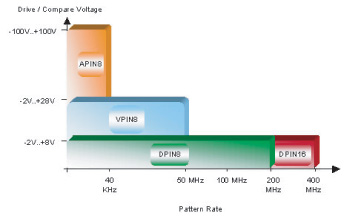
Figure 3. Three different pin types cover a wide range of test requirements:
- DPIN: Digital mixed signal pin for high speed digital needs;
- VPIN: Digital mixed-signal pin with high-voltage test capability, its 30 V voltage swing and 50 MHz data rate are well suited to the testing needs of automotive devices;
-APIN: Analog mixed-signal pin for high-voltage, high-precision, +-100 V/40 mA per-pin parameter measurement unit (PMU) for power mixed-signal testing in the automotive industry.
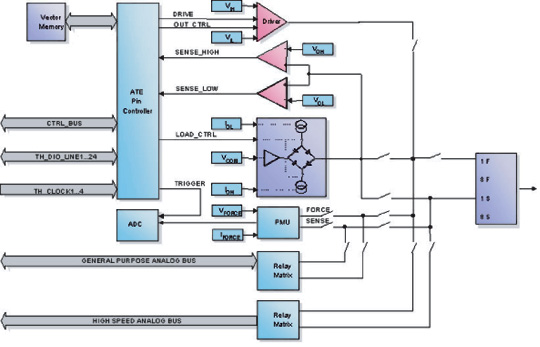
Figure 4, a multi-function mixed-signal pin structure diagram.
Multi-function mixed signal pin electronic performance
The versatile mixed-signal pin VPIN includes several functional blocks such as vector memory, ATE pin controller, driver, comparator, load, and PMU for each channel.
The controller consists of a sequence generator, a timing generator, a formatted device, and comparison logic. The digital matrix provides interfaces to digital instruments such as timers, counters, time measurement units, and triggers for synchronization and triggering.
Through the analog matrix, each pin channel can be used with analog instruments such as VI sources, system voltmeters, and DSP instruments, and software can simplify the design of the load board and the integration of additional test and measurement circuits. The onboard controller allows for parallel measurements. The drive/feedback technique guarantees accurate analog excitation and allows VPIN to be used in split mode, which doubles the test pin channel. Split mode allows the drive and probe paths to be in the same direction.
The new digital pin VPIN is designed to meet the specific testing needs of automotive devices up to 25V (typically 14V) for stress testing. VPIN is a high voltage mixed signal pin with good digital test performance. It provides a 30V voltage swing and a data rate of up to 50MHz for testing high voltage, high speed mixed signal devices.
The true per-pin tester architecture provides high flexibility and complete parallel testing capabilities. A separate sequence of each pin produces a synchronous or asynchronous digital pattern that allows for different data frequencies to occur.
The vector memory stores test vectors, sequence instructions, format, and timing information. The memory contains stimulus/expected data that is used to verify the output data of the device. The transmit and receive memories support real-time recording, which is required for ADC testing. The data in the memory can be read while the vector is running. A separate PMU for each pin allows parallel DC parameter testing. Each channel can be connected to analog and digital instruments via software controlled line switching. The onboard controller stores different test settings that can be called in parallel to perform tests quickly. The controller can be turned off to reduce noise when making high-accuracy analog measurements. The drive/feedback structure guarantees advanced analog accuracy.
The Cliden Falcon system has up to 128 VPIN pins.
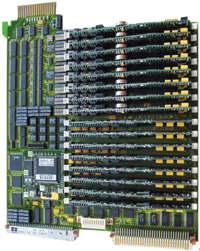
Figure 5. Multi-function mixed-signal pin.
Important instrument
VI sources can choose high-performance VI sources to cover the testing needs of a wide range of automotive applications. VI sources can operate from low current to high power. All sources are floating and can be operated in four quadrants. On-board measurements support parallel testing, which allows control and triggering of VIs through test vectors. The highest reliability is achieved through alarm and protection functions. Many other features, such as the superposition and parallel use of VI sources, ensure maximum performance and flexibility.
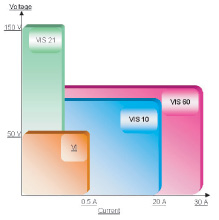
Figure 6. V/I source – flexibility from nA to kW.
DSP Generators and Digitizers Caledon's Falcon and Piranha systems offer several DSP instrument options with resolutions up to 20 bits and sampling frequencies up to 200 MHz. DSP generators and digitizers can meet the testing needs of a wide range of analog waveforms for automotive devices. Each DSP instrument has a dedicated DSP engine that provides true parallel testing capabilities. Each channel's independent digitizer DSP engine provides the fastest measurement in the time or frequency domain. All digitizers and DSP generators can be synchronized with the relevant samples provided.
The embedded bus of the system bus ensures synchronization between all instruments in the system. Synchronization of digital, analog, DSP, and power instruments can be done smoothly. Triggering the occurrence of the synchronization signal using the trigger line and measuring the measurement of critical time parameters can be performed relatively easily. These unique synchronization capabilities guarantee maximum flexibility and productivity.
In general, Falcon and Piranha are flexible solutions to the challenges of mixed-signal testing of automotive devices. As needed, the Credence test system meets the needs of digital, analog, DSP and power supply testing for automotive applications. With high-speed instrumentation and parallel testing technology, Credence's systems offer the highest throughput and lowest test costs. The structure and interconnection of each pin tester guarantees a high degree of flexibility. Advanced software toolkits provide integrated tools for the shortest development to production time.
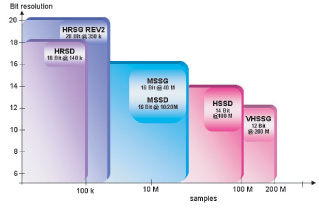
Figure 7. DSP generator and digitizer – flexibility from high precision to high speed
Die-Casting Products,Led Housing Die Casting,Aluminum Die Casting Product,Aluminum Die Casting Led
Yangzhou Huadong Can Illuminations Mould Manufactory Co., Ltd. , https://www.light-reflectors.com
